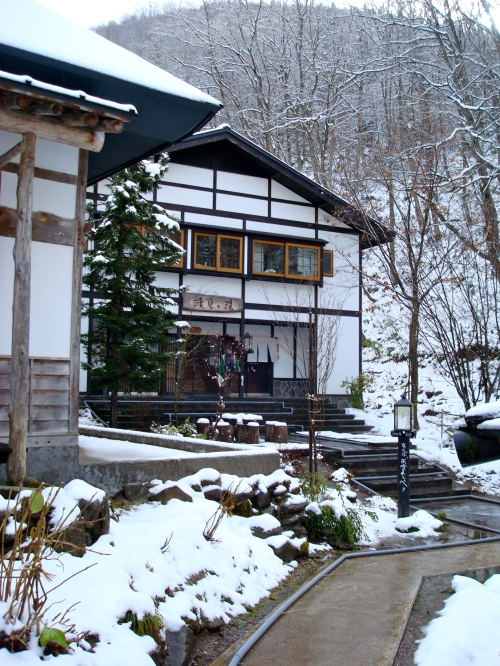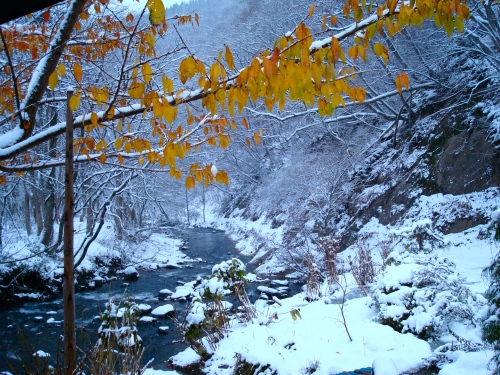November was a busy month for many reasons, but probably the best one was that there was a surge in the amount of cool people in Aomori-ken by 3. I had to rent them from America, but they took on the responsibility with courage and style.
Sophy and Cliff, on their maiden voyage to the Far East, met us in Hirosaki (a city in my prefecture) on a Friday, as I was finishing up a several day seminar for work. We greeted them at the train station in the early evening, and booked it to a ryokan (bed & breakfast) onsen I had found through hard internet sleuthing. Sophy had relayed her desire to experience rural Japan, and what better place to do that than in Aomori-ken….quite literally the furthest, rural reaches on the Japan mainland.
The drive was straightforward at first – a couple main thoroughfares out of Hirosaki and in about 30 minutes we were passing by a town called Kuroishi. From Kuroishi, our directions took us left off the main road to a much smaller road that began ascending rapidly. Soon, traces of snow and ice could be seen on the road. Then, the pavement gave way to gravel and dirt. There were no longer any street lights, or signs of life, for that matter. We drove for what seemed like hours, first topping out on a mountain, and then descending on dark, slippery roads into a valley. I was glad to be in Carly’s Rav4.
Finally, after what seemed like forever, we passed a couple cars parked in a cleared out lot and made one last, very steep pitch to Aoni. We entered the building, carefully taking off our outside shoes and replacing them with indoor slippers. It took a second for my eyes to adjust to the low lighting, but what I registered was dark wood paneling on the floors and walls, a warm, glowing wood-burning stove standing in the entry, a little “general store” to one side, and a lady seated behind the check-in desk further in front of us – everything lit up by lamplight.
We were shown to our rooms – the top (and only) floor of one of their several buildings, above one of the four bath houses. Each room was in traditional tatami, set up with a table, two hot pots of water and loose-leaf tea, and zabuton floor pillows for encircled seating. The only light in the room was one glowing lamp hanging from a hook in the ceiling. A note read: Please do not adjust. This is as high as it will go. But in Japanese. For bed time, we laid out the futons kept folded in the closet, marveled at the Engrish translation for the directions, and piled on fluffy, down comforters to keep the wintry chill at bay.

Stream passing through the Aoni compound

Our guesthouse, top floor, above our own "private" baths

Another of the guesthouses
What ensued were two nights and one full day of utter relaxation. Dinner and breakfast was served in the main building in a communal room; long low tables surrounding a central fire pit. The first night, we arrived to find a whole, skewered brook trout, salted and roasted above an open flame as our main protein. The look on his little face was one of utter astonishment. Other small dishes included fresh salmon sashimi, kabocha squash tempura, a hot pot soup dish with scallops and seasonal mushrooms, and of course…daikon. (What Japanese meal isn’t complete without this wonder radish??)

Dining room aglow
Between eating, we soaked in the four different baths at the ryokan, napped and read. The one directly below us, sex segregated was of a pretty hot temperature, with an outdoor area just above body temperature. The contrast between the two was welcoming. The next one closest to our house was a large, mixed, outdoor tub, completely inlaid with natural river stones and big enough for at least 10 people. Unfortunately, the water wasn’t quite toasty enough to stay in long, but the highlight for this area was the “love tub” a couple feet off, a deep barrel, constantly being replenished by steaming hot water, and big enough for a cozy couple. The third bath was indoors in the main building. It was basic and looked out onto a patch of scrub and trees. The fourth one, set in a building a little ways in front of the main entrance, was divine. The room was completely built out of soft beige hiba wood, a Japanese species of cypress, which is particularly plentiful in northern Japan. It had tall, cathedral-like ceilings and floor to ceiling windows on two sides. This bath, however, was so hot that the room steamed up entirely. On the women’s side, there was an outdoor bath, one set into the ground, and the other a wooden and rust witch’s cauldron, both boasting the perfect temperature of water, and overlooking a snowy river scene, accentuated by the last remaining golden leaves of a tree.

Fourth Bathhouse

View from the outdoor tub in Bathhouse IV

The gang looking groggy (minus Carly & Karissa, behind camera) on our last day at breakfast. Check out the cool yukata robes we were provided!
Despite the service – which frankly was a little off-putting, my guess is due to our gaijin (foreigner)ness – it was a relaxing and quintessential Japanese stay. One of those times, while I soak my weary bones, dreamily gazing out at a Japanese landscape, that I know I can only do this in Japan. And I am thankful for it, and being able to share this Japan – what has become my Japan – with visitors. Coincidentally, this thankfulness fell at a good time of year, as we returned to Kazamaura together on Sunday, to create and share a delicious Thanksgiving feast, and to toast new friends, old friends, and faraway loved ones – and all that is peaceful, and as it should be, in life.
Read Full Post »




















